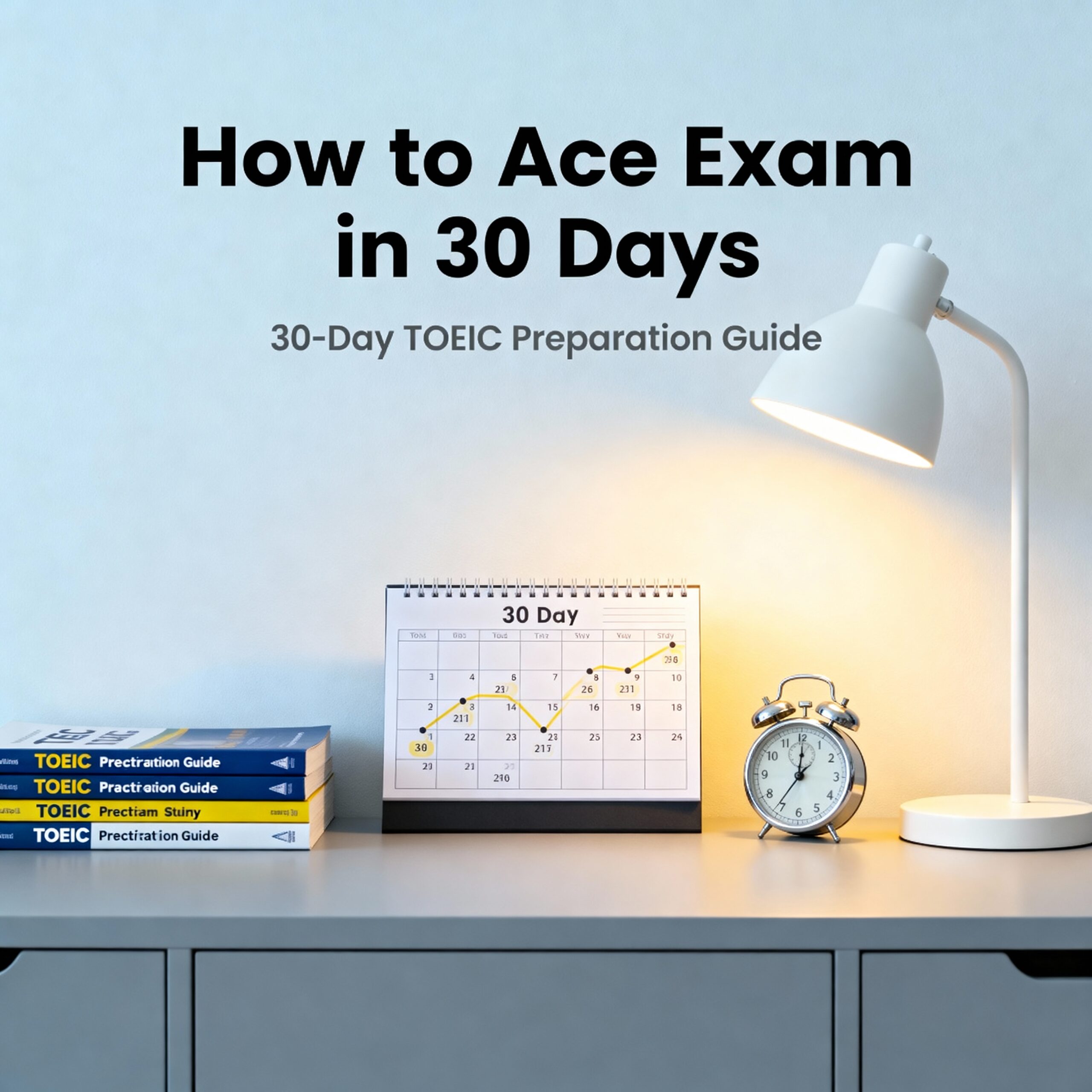TOEIC Reading Strategies: How to Boost Your Score by 30% in 14 Days

What if the key to dramatically improving your TOEIC reading score isn’t studying harder, but simply studying smarter?
Most test-takers spend weeks or even months preparing for the TOEIC Reading Strategies section, yet see only modest improvements. They focus on memorizing vocabulary lists and grammar rules, often missing the strategic approaches that could transform their results. But what if you could significantly boost your score in just two weeks with the right techniques?
This might sound too good to be true, but I’ve helped hundreds of students achieve exactly this kind of rapid improvement. The secret isn’t in knowing more English—it’s in knowing how to tackle the test itself. Let me share the recipe for TOEIC reading success that has consistently delivered results for my students.
Overview: A Fast-Track Strategy for TOEIC Reading Success
This 14-day TOEIC reading improvement plan isn’t like other preparation methods. Instead of trying to improve your overall English ability (which takes months or years), we focus on test-specific strategies that deliver immediate score improvements.
Time requirement: 60-90 minutes daily for 14 consecutive days
Difficulty level: Moderate (suitable for those with basic English reading skills)
Expected results: 30-40% score improvement for most test-takers
What makes this approach special is its laser focus on the highest-yield activities. We’ll target the specific reading skills and question types that give you the most points in the shortest time. This plan works because it’s built around how the TOEIC test is constructed, not generic English improvement.
Essential Ingredients: Your TOEIC Reading Success Toolkit
Like any good recipe, our TOEIC reading strategy requires specific ingredients. Here’s what you’ll need:
1. Skimming and Scanning Techniques
- What: Methods to quickly find specific information without reading every word
- Why it matters: The TOEIC reading section has too much text to read thoroughly
- Substitution option: If you struggle with these techniques, use paragraph analysis instead
2. Time Management Framework
- What: A specific allocation of minutes for each reading section
- Why it matters: Running out of time is the #1 score killer on the reading section
- Substitution option: Question prioritization if strict timing causes anxiety
3. Answer Elimination Strategy
- What: A systematic approach to crossing out wrong answers
- Why it matters: Finding the correct answer is easier when you’ve eliminated distractors
- Substitution option: Confidence ranking if you prefer not to eliminate answers entirely
4. Vocabulary Attack Plan
- What: Techniques for handling unfamiliar words
- Why it matters: You’ll encounter unknown vocabulary even with extensive preparation
- Substitution option: Context clues if word-building strategies are challenging
5. Structure Recognition Tools
- What: Methods to quickly identify text organization patterns
- Why it matters: Understanding structure helps predict where information will appear
- Substitution option: Keyword highlighting if structural analysis is difficult
6. Practice Materials
- What: Official TOEIC practice tests or high-quality mock exams
- Why it matters: Authentic practice materials ensure realistic preparation
- Substitution option: Free online resources if official materials are unavailable
7. Progress Tracking System
- What: A simple way to record your improvement and identify weaknesses
- Why it matters: Targeted practice on weak areas accelerates improvement
- Substitution option: Simple right/wrong tallies if detailed tracking is overwhelming
Step-by-Step Instructions: Your 14-Day Improvement Plan

Days 1-2: Foundation Building and Diagnosis
Morning Session (30 minutes):
- Take a TOEIC reading practice test under timed conditions
- Score your test, marking each question you got wrong
- Categorize your errors by question type:
- Incomplete sentences
- Text completion
- Reading comprehension
- Create a simple chart showing your accuracy percentage for each type
Afternoon/Evening Session (30-60 minutes):
- Learn the basic skimming technique:
- Read the first and last sentence of each paragraph
- Glance at any bold or italicized text
- Look for transition words (however, therefore, additionally)
- Practice skimming with 5 short business articles
- Time yourself and gradually try to skim faster
Days 3-4: Time Management and Question Types
Morning Session (30 minutes):
- Study the structure of the TOEIC reading section:
- Part 5: Incomplete Sentences (40 questions, 30 seconds each)
- Part 6: Text Completion (12 questions, 1 minute each)
- Part 7: Reading Comprehension (48 questions, 1-2 minutes each)
- Create a time allocation plan based on your strengths and weaknesses
- Practice following your time plan with a small set of questions
Afternoon/Evening Session (30-60 minutes):
- Focus on Incomplete Sentences (Part 5):
- Identify the common grammar patterns tested
- Practice identifying sentence structure before looking at options
- Learn to quickly eliminate grammatically impossible answers
- Complete 20 practice questions using these techniques
Days 5-6: Vocabulary Strategy and Text Completion
Morning Session (30 minutes):
- Learn vocabulary attack strategies:
- Break unknown words into prefixes, roots, and suffixes
- Use surrounding context clues to guess meaning
- Look for similar words you already know
- Practice with 15 difficult TOEIC vocabulary words
Afternoon/Evening Session (30-60 minutes):
- Focus on Text Completion (Part 6):
- Practice reading for logical flow and coherence
- Learn to identify connector words and relationships between sentences
- Look for pronoun references to connect ideas
- Complete 2-3 Text Completion practice sets
Days 7-8: Reading Comprehension and Scanning
Morning Session (30 minutes):
- Learn the scanning technique:
- Quickly search for specific information (names, dates, numbers)
- Use your finger or cursor to guide your eye down the page
- Look only for key terms related to your question
- Practice scanning with progressively longer texts
Afternoon/Evening Session (30-60 minutes):
- Focus on Reading Comprehension (Part 7):
- Learn to read questions before reading the passage
- Practice identifying question types (main idea, detail, inference)
- Develop strategies for each question type
- Complete 2 single-passage reading sets
Days 9-10: Answer Elimination and Double Passages
Morning Session (30 minutes):
- Master the answer elimination strategy:
- Immediately cross out grammatically incorrect options
- Eliminate answers that contradict the passage
- Cross out choices that are partially correct but contain wrong information
- Practice with 20 questions across all reading parts
Afternoon/Evening Session (30-60 minutes):
- Focus on double passages in Part 7:
- Learn to identify which passage contains the answer to each question
- Practice quickly determining relationships between passages
- Develop strategies for questions that require information from both texts
- Complete 3 double-passage practice sets
Days 11-12: Speed Drills and Integration
Morning Session (30 minutes):
- Conduct speed drills:
- Part 5: Complete 20 questions in 8 minutes
- Part 6: Complete 1 set in 3 minutes
- Part 7: Skim a single passage in 45 seconds
- Focus on balancing speed and accuracy
Afternoon/Evening Session (30-60 minutes):
- Integrate all strategies with mixed practice:
- Complete a full reading section under timed conditions
- Apply appropriate techniques to each question type
- Track both speed and accuracy
- Review errors and adjust strategies as needed
Days 13-14: Full Practice Tests and Fine-Tuning
Day 13 (90 minutes):
- Take a complete TOEIC reading practice test
- Use all the strategies you’ve learned
- Strictly follow your time management plan
- Score your test and analyze your performance
- Identify any remaining weak areas
Day 14 (90 minutes):
- Address specific weakness areas with targeted practice
- Review all strategies and create reminder notes
- Take a final practice test to measure improvement
- Compare with your Day 1 score to see your progress
- Mentally rehearse applying these strategies on test day
Assembly: Putting It All Together on Test Day
Now let’s combine all these ingredients into a complete test-day approach:
Before Starting the Reading Section
- Take three deep breaths to center yourself
- Quickly review your time allocation plan
- Remember your primary strategies for each question type
- Prepare your answer sheet for efficient marking
For Part 5 (Incomplete Sentences)
- Read the sentence quickly to identify the grammatical pattern
- Look for clues about the missing word’s part of speech
- Eliminate any grammatically impossible options
- Choose the answer that makes the sentence grammatically correct and logical
- Spend no more than 30 seconds per question
For Part 6 (Text Completion)
- Skim the entire text first to understand the topic and flow
- For each blank, read the sentence before and after it
- Look for connector words and pronoun references
- Choose the option that maintains logical flow and correct grammar
- Spend about 1 minute per question
For Part 7 (Reading Comprehension)
- Read the questions first to know what to look for
- Quickly skim the passage to identify its structure and main idea
- Scan for specific information needed to answer each question
- For double passages, determine which passage contains the answer
- Use the answer elimination strategy when uncertain
- Spend 1-2 minutes per question, depending on passage length
Presentation Tip: On test day, work in the order that maximizes your score. If Part 5 is your strongest section, do it first to build confidence and secure those points.
Storage and Make-Ahead Tips: Maintaining Your TOEIC Reading Skills

These strategies are like muscles—they need regular exercise to stay strong. Here’s how to maintain your skills:
Short-Term Storage (1-2 weeks before the test)
- Review your strategy notes daily
- Complete at least one practice section every other day
- Focus on maintaining speed rather than learning new techniques
Medium-Term Storage (1-3 months)
- Complete one full practice test weekly
- Review error patterns biweekly
- Refresh your strategy approach monthly
Long-Term Storage (3+ months)
- Read business articles using your skimming techniques
- Complete a TOEIC reading section monthly
- Maintain vocabulary through spaced repetition apps
Freshness Tip: The week before your test, don’t attempt to learn any new strategies. Instead, focus on reinforcing what you already know and getting proper rest.
TOEIC Variations: Adapting Your Strategy for Different Scenarios
The basic recipe works for most test-takers, but you might need to adjust based on your situation:
For Advanced English Speakers
- Focus more on speed and less on vocabulary development
- Spend extra time practicing the most difficult double passages
- Challenge yourself with stricter time limits than the actual test
For Beginners
- Allocate more time to vocabulary building
- Focus first on Part 5, which offers the most points for the time invested
- Consider skipping the most difficult passages and returning if time allows
For Test Retakers
- Analyze your previous score report for patterns
- Double down on practice for your weakest section
- Time yourself strictly to avoid previous timing mistakes
For Limited Practice Time
- Focus exclusively on Parts 5 and 6, which offer more points per minute
- Master the answer elimination strategy above all others
- Prioritize official practice materials over other resources
TOEIC Exam: Why 90% of Test Takers Miss These 3 Tips
Conclusion: Your TOEIC Reading Transformation
The strategies in this 14-day plan have helped thousands of test-takers dramatically improve their TOEIC reading scores. The beauty of this approach is that it works regardless of your current English level—because it’s about working smarter, not harder.
Remember that consistency is key. Following this plan for 60-90 minutes daily for two weeks will yield far better results than cramming for several hours the night before your test.
Trust the process, follow the recipe, and you’ll likely see that 30% score improvement—or even more. Your TOEIC success is within reach!
What strategy will you implement first? Start your 14-day transformation today, and share your progress in the comments below.
FAQs About TOEIC Reading Strategies
Q: Do I really need to practice every day for this to work?
A: Daily practice delivers the best results, but if you can’t manage it, aim for at least 5 days per week. Consistency matters more than session length.
Q: Will these strategies work if my English level is very basic?
A: Yes! These strategies are especially helpful for lower-level English speakers because they don’t require perfect comprehension of every word. You’ll learn to find answers even when you don’t understand everything.
Q: I’m already scoring above 350 on the reading section. Can I still improve by 30%?
A: Higher scorers might see percentage improvements closer to 15-20%, but that could still mean 50-70 additional points, which is significant at the upper levels.
Q: Which part of the reading section should I focus on most?
A: Part 7 (Reading Comprehension) is worth the most points but also takes the most time. For efficiency, many test-takers find the best return on investment comes from mastering Part 5 first.
Q: Do I need to buy official TOEIC preparation materials?
A: While official materials provide the most authentic practice, there are many free or low-cost alternatives online. The strategies themselves are more important than the specific practice texts.
Q: How soon before my test should I complete this 14-day plan?
A: Ideally, finish the plan 3-7 days before your test. This gives you time to rest while keeping the strategies fresh in your mind.
Q: What if I don’t see improvement after 14 days?
A: First, ensure you’re tracking your progress correctly. If you truly haven’t improved, it might indicate that you need to adjust your approach to match your learning style or that you need more focus on English fundamentals alongside these strategies.






